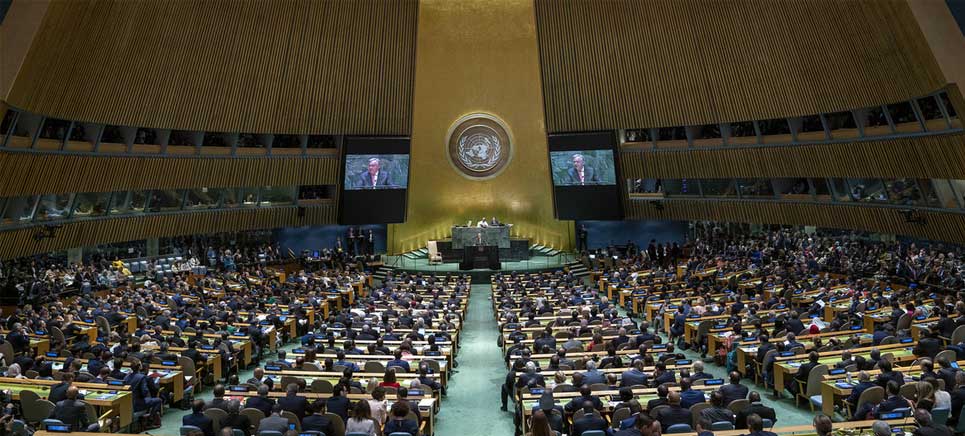United Nations General Assembly (UNGA) is one of the six principal organs of the United Nations. It is in fact the main representative organ of the UN. All the 193 UN Member Nations also serve as members of the General Assembly. Deliberations on issues of international importance, decision-making, and policy-formulation are integral functions of the General Assembly. It has been a part of the UN system since the very beginning.
Interestingly, the General Assembly is sometimes informally referred to as the first branch of the UN. This is probably because sequentially it is the very first organ mentioned in the UN Charter. The General Assembly derives its powers from Chapter IV of the UN Charter, 1945. Chapter IV deals with all important aspects of the General Assembly including its composition, structure, procedures, responsibilities, etc.
In this article, we will cover all the important details related to the United Nations General Assembly. However, before exploring more about the General Assembly, let’s have a look at some of the quick facts related to the General Assembly.
Quick Facts about United Nations General Assembly
- Headquarters: New York (United States of America)
- Established: 1945
- Source of Establishment: UN Charter of 1945
- Rule/Provision: Chapter IV of the UN Charter
- First Session: 10 January 1946 in the Methodist Central Hall (London)
- Total number of members (Initially): 51 Member Nations
- Total number of members (Presently): 193 Member Nations
- Method of Voting on Resolutions: Through Special Majority (Important Questions) & Simple Majority (All Other Questions)
History of the General Assembly
First session of the General Assembly was attended by the initial 51 Member Nations of the United Nations. It took place at the Methodist Central Hall (London). During the initial years, the permanent UN Headquarters were still being constructed. It took almost 7 years for the UN Headquarters to host the first meeting of the General Assembly. The first formal annual meeting of the General Assembly at the UN Headquarters was held on 14 October 1952.
Post-1952, it was only once in 1988, that a General Assembly session was not organized at the UN Headquarters. Palestine Liberation Organization’s Yasser Arafat, who was supposed to address the 29th UNGA session, was denied entry by United States a week prior to the session. This led to a change of venue and the meeting shifted from UN Headquarters in New York to the Palace of Nations in Geneva (Switzerland).
Important Powers & Functions of UNGA
- The General Assembly holds the “power of the purse” for the United nations. It has been bestowed with the power to consider and approve the UN Budget.
- It is responsible for some important UN appointments such as:
- Appointment of Secretary-General to the UN
- Appointment of Non-Permanent Members of the UN Security Council
- The General Assembly receives and considers annual and special reports from the Security Council as well as other organs of the UN
- It can also initiate studies and make recommendations for the purpose of international co-operation in various fields as mentioned in Article 13 of the UN Charter. Some of the mentioned fields are politics, economic, social, cultural, educational, health, etc.
- It performs important functions with respect to the international trusteeship system. These functions include the approval of the trusteeship agreements for areas not designated as strategic.

Membership of the UNGA
All the nations that are members of the United Nations are also the members of UN General Assembly. As on date, there are a total of 193 Member Nations of the General Assembly. Additionally, the Holy Sea and Palestine have been granted the observer status at the General Assembly. The General Assembly is also empowered to grant observer status to any international entity or organization.
Resolutions at the UNGA
A resolution is a declaration or decision introduced in the General Assembly. Member nations cast vote on the draft resolution. These resolutions are usually non-binding in nature. However, when the Security Council fails to tackle an important peace and security issue, the General Assembly comes to rescue. The UNGA Resolution 377 A, also known as the “Uniting for Peace Resolution“, is important in this regard. This resolution empowers the General Assembly to immediately consider important matters where the Security Council lacks unanimity and makes recommendations for collective measures by the member nations.
Voting on Resolutions in UNGA
In order to be passed, a resolution may require a special majority or a simple majority of the General Assembly members. The kind of majority required depends on the nature of the question or issue mentioned in the resolution.
Simple Majority
A resolution requires more than half of total votes (50% votes + 1 vote) to pass with simple majority. Usually, resolutions are “passed” at the General Assembly by a simple majority of members present and voting
Special Majority
This kind of majority is required in special cases involving important questions of international peace and cooperation. In order to be declared as “passed” under this category, such a resolution must receive 2/3rd majority of the total votes by the members present and voting.
Some of the issues requiring a special majority are:
- Admission of new UN members
- International peace & security
- Suspension of right and privileges of members
- UN Budget and related questions
- Expulsion of a present member
Sessions of the UNGA
The General Assembly sessions are usually headed by its President or the Secretary-General to the United Nations. These sessions take place at the UN headquarters in New York (United States of America). There are three types of sessions that are conducted by the General Assembly.

Regular Session
The General Assembly meets annually in the month of September. The session begins on the third Tuesday of September and goes on intensively till December. The session again resumes in January and it continues until all agendas are discussed.
Special Session
Apart from a regular session, a special session may be called any time throughout the year at the request of:
- The Security Council
- Majority of the member nations of the General Assembly
- Any one member nation (provided majority of the members concur)
Emergency Special Session
As the name suggests, it is called under extreme circumstances. Thus, these meetings are called within 24 hrs at the request of:
- Security Council (on the vote of 9 council members)
- Majority of the members of the General Assembly
- One member (provided majority of the members concur)
So far, only 10 Emergency Special Sessions of the General Assembly have been called. The last such session (10th Emergency Special Session) was conducted on the issue of Israeli- Palestinian conflict.
Seating Arrangement in the UNGA
There is a specific scheme of seating arrangements in the General Assembly. English names of all member countries are taken into consideration and seats are allotted in alphabetical order. UN Secretary-General decides the first letter of the alphabetic order through a ballot draw. This determines the nation that will be occupying the front-left most seat. Once the first nation is determined, the remaining member nations are allotted seat in alphabetical order following the first name.
Subsidiary Organs of the UNGA
The subsidiary organs of the United Nations General Assembly is divided into five categories.
- Committees
- Commissions
- Boards
- Councils & Panels
- Working Groups & Others
Prior to every plenary session of the General Assembly, a discussion on its Agenda take place. The subsidiary organs accordingly seek to establish a harmony in approaches of the member nations towards the Agenda. These organs then present their recommendations in draft form. The draft is introduced in the plenary session as “resolutions” for consideration.
Use the citation below to add this article to your bibliography
"UN General Assembly: Functions, Resolutions, History." Dashamlav.com. Web. 12 June 2025. <https://dashamlav.com/united-nations-general-assembly-functions-resolutions-history/>
Dashamlav.com, "UN General Assembly: Functions, Resolutions, History." Accessed 12 June 2025. https://dashamlav.com/united-nations-general-assembly-functions-resolutions-history/
"UN General Assembly: Functions, Resolutions, History." (n.d.). Dashamlav.com. Retrieved 12 June 2025 from https://dashamlav.com/united-nations-general-assembly-functions-resolutions-history/
